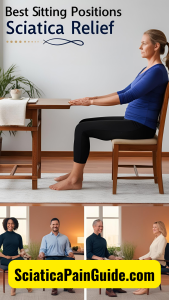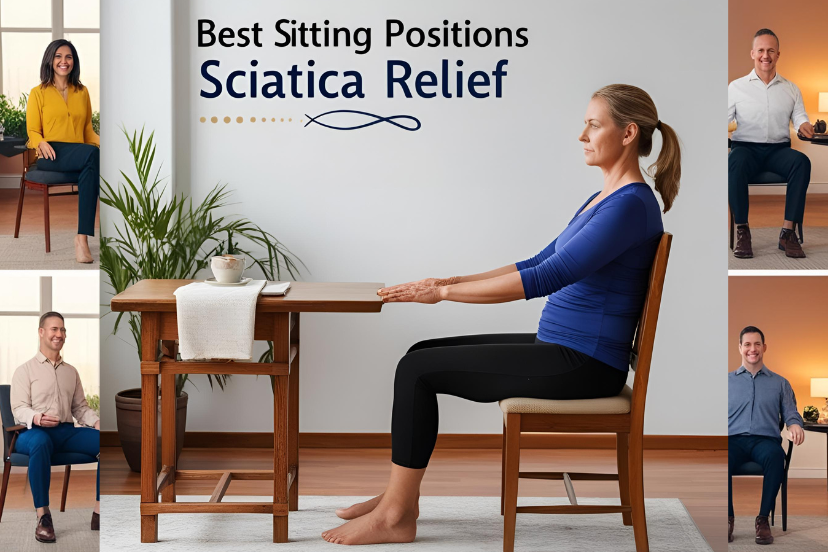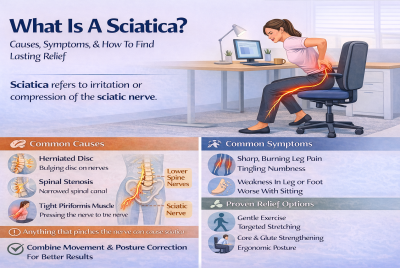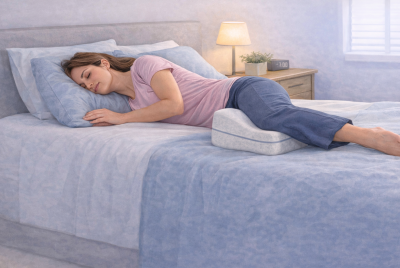The Best Sitting Positions for Sciatica Relief: What Works and What to Avoid
If you suffer from sciatica, you probably already know that sitting can be one of the most uncomfortable triggers of nerve pain. Whether you’re working from home, commuting, or trying to relax, prolonged sitting can worsen pressure on the sciatic nerve, making your pain flare up fast.
But here’s the good news: changing how and where you sit can make a massive difference. In this guide, we’ll break down the best sitting positions for sciatica, show you what to avoid, and offer DIY cushion tips to help you stay comfortable all day long.
🔥 Why Does Sitting Trigger Sciatica Pain?
Sciatica is caused by compression or irritation of the sciatic nerve, which runs from your lower back, through your buttocks, and down each leg. When you sit for long periods, especially with poor posture, several things can go wrong:
-
Your pelvis tilts backward, placing stress on spinal discs
-
Tight hip flexors and glutes compress the nerve
-
Poor support can lead to slouching, further irritating the lumbar spine
🚫 Result: Increased pressure on the sciatic nerve = more pain, tingling, and numbness down your leg.
That’s why finding the right sitting position is key for managing sciatica day-to-day.
✅ Best Sitting Positions for Sciatica Relief
Let’s look at some of the top sitting positions to reduce sciatic nerve compression.
1. Sit with Knees Slightly Lower Than Hips
This posture helps reduce strain on the lower back and encourages a neutral spine.
How to do it:
-
Sit on a chair with a slight recline or lumbar support.
-
Keep your feet flat on the ground.
-
Use a small cushion or wedge under your buttocks to elevate your hips slightly.
Why it works: Raising the hips opens the angle between the torso and thighs, relieving sciatic nerve pressure.
2. Use a Lumbar Support Pillow
Whether you’re in a car or an office chair, using a lumbar cushion helps keep the spine in its natural S-curve.
Tips:
-
Position the cushion at your lower back (L4–L5 area).
-
Avoid over-arching your spine — it should feel natural, not forced.
3. Reclined Sitting with Feet Elevated
A slightly reclined seat takes pressure off the spine and hips.
Setup:
-
Use a reclining office chair or an adjustable backrest.
-
Prop your feet on a low stool or footrest.
Pro Tip: This works especially well for disc-related sciatica because it reduces spinal compression.
4. Sitting on an Exercise Ball (Briefly)
An exercise ball can help activate your core and improve posture, but it’s best used in short bursts.
Use for: 15–20 minutes at a time to strengthen postural muscles.
5. Forward Tilt Sitting
Some ergonomic chairs or kneeling chairs allow your pelvis to tilt slightly forward, promoting a natural curve in the spine.
Why it works: It shifts your weight from the tailbone to the thighs, reducing nerve compression in the lower back.
Best Sitting Positions for Sciatica
🪑 Ergonomic Chair Tips for Sciatica
The chair you use can make or break your sciatica management. Here’s what to look for in a sciatica-friendly ergonomic chair:
✔️ Features to look for:
-
Adjustable seat height (hips should be slightly higher than knees)
-
Lumbar support
-
Tilt or recline feature
-
Seat depth control (so your thighs are supported without pressure behind the knees)
-
Memory foam or pressure-relief cushion
❌ Avoid:
-
Overly soft chairs or couches
-
Bucket-style seats (common in cars)
-
Chairs that don’t support your lower back
🛠️ Can’t afford a high-end ergonomic chair? A quality seat cushion and back support pillow can make a huge difference.
🚫 Sitting Positions to Avoid With Sciatica
Knowing what not to do is just as important. Avoid these common habits:
1. Crossing Your Legs
This may feel relaxing, but it twists the pelvis and can increase pressure on the sciatic nerve, especially on one side.
2. Slouching or Leaning Forward
Slumping compresses spinal discs and adds pressure to your lower back — a big no-no for anyone with herniated discs or lumbar stenosis.
3. Sitting for Long Periods Without Moving
Even if your posture is perfect, staying still for too long reduces circulation and aggravates nerve inflammation.
Solution: Set a timer to stand, stretch, or walk every 30–45 minutes.
4. Perching on the Edge of Your Seat
This position lacks support and puts extra tension on your hip flexors and lower back muscles.
🛠️ Bonus: DIY Cushion Tips for Sciatica Relief
If you’re not ready to invest in an expensive ergonomic chair, a well-made cushion setup can do wonders. Here are a few DIY tips:
1. Use a Wedge Cushion
Wedge cushions tilt your pelvis forward, improving spinal alignment.
-
Look for high-density foam
-
Choose one with a cut-out for the tailbone (coccyx relief)
2. Make Your Own Lumbar Support
Roll up a towel or small pillow and place it behind your lower back. You can experiment with the size until it fits comfortably in your lumbar curve.
3. Dual-Cushion Setup
Use one cushion for your lower back and another under your hips to maintain a gentle forward pelvic tilt and relieve sciatic pressure.
4. Avoid Memory Foam That’s Too Soft
It might feel great at first, but overly soft cushions can sink too much and cause posture collapse, worsening your pain over time.
📌 Quick Tips Recap
-
✅ Do: Sit with feet flat, hips slightly above knees, and use lumbar support.
-
❌ Avoid: Crossing legs, slouching, sitting for long stretches.
-
🪑 Invest in: Ergonomic chairs or cushions with pelvic and lumbar support.
-
🔁 Move often: Take breaks every 30–45 minutes to stretch or walk.
❓ FAQs About Best Sitting Positions for Sciatica
1. What is the best sitting position for sciatica pain relief?
The best sitting position is one where your hips are slightly higher than your knees, your feet are flat on the floor, and your spine is supported in a natural curve. Using a lumbar support pillow and a wedge cushion can greatly improve comfort.
2. Is it better to sit or lie down with sciatica?
It depends on the severity and cause of your sciatica. Many people find that short periods of reclining or lying down help reduce nerve pressure. However, prolonged inactivity can worsen symptoms, so alternating between positions is best.
3. Can sitting too much make sciatica worse?
Yes. Sitting for long periods compresses the spine and tightens the hips, which can worsen sciatica symptoms. Take frequent breaks to stand, stretch, or walk every 30–45 minutes.
4. Are recliners good for sciatica?
Recliners can be helpful if they offer proper lumbar support and allow your legs to elevate slightly. Avoid overly soft recliners that cause you to sink in and lose spinal alignment.
5. Should I use a standing desk for sciatica?
Yes, a standing desk can help reduce sitting time and improve posture, but standing too long without support may also cause discomfort. The best approach is to alternate between sitting and standing throughout the day.
🧘♂️ Final Thoughts: Sit Smart, Move Often
Sitting doesn’t have to be painful, but how you sit matters just as much as where you sit. With a few adjustments to your posture, chair, and cushion setup, you can dramatically reduce sciatic pain during the day.
Combine smart sitting with regular stretching, strengthening exercises, and lifestyle changes to keep your sciatic nerve happy and healthy.
Disclaimer
Please note that this article should not replace professional medical advice. Consult a healthcare professional for an accurate diagnosis and tailored treatment plan.
👉 Next Steps:





